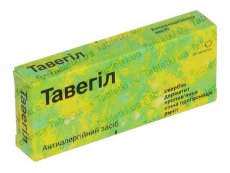Medical expert of the article
New publications
Preparations
Tavegil
Last reviewed: 03.07.2025

All iLive content is medically reviewed or fact checked to ensure as much factual accuracy as possible.
We have strict sourcing guidelines and only link to reputable media sites, academic research institutions and, whenever possible, medically peer reviewed studies. Note that the numbers in parentheses ([1], [2], etc.) are clickable links to these studies.
If you feel that any of our content is inaccurate, out-of-date, or otherwise questionable, please select it and press Ctrl + Enter.

Tavegil is a synthetic antiallergic (antihistamine) drug of the ethanolamine histamine receptor blockers group. Other trade names of this drug are Alagil, Angistan Clemastine, Lekazol, Meclastine, Mecloprodin fumarate, Reconin, Rivtagil, Tavist, Fumartin.
Indications Tavegil
Tavegil is prescribed for allergies that manifest themselves in the form of:
- vasomotor rhinitis (nasal congestion and runny nose),
- skin rashes and itching,
- as well as for dermatoses accompanied by itching,
- reactions to insect vinegars and drug allergies.
Tavegil (injections) is used for serum sickness, in case of angioedema (Quincke's edema) and anaphylactic shock.
Release form
Tavegil is available in the form of tablets (0.001 g), syrup (in 60 ml or 100 ml bottles, a measuring spoon is included) and 0.1% injection solution (in 2 ml ampoules).
 [ 1 ]
[ 1 ]
Pharmacodynamics
The therapeutic effect of Tavegil is based on its active substance - 1-methyl-2-[2-(α-methyl-para-chlorobenzhydryloxy)-ethyl]-pyrrolidine in the form of fumarate, which affects the release of the endogenous neurotransmitter of immediate-type allergic reactions - histamine.
This occurs due to blocking the stimulation of peripheral H1 histamine receptors located on the outer surface of the cytoplasmic membrane of cells. As a result, histamine synthesis does not increase, capillary permeability decreases, and - as a consequence - allergic reactions of the body in the form of hyperemia and itching of the skin, irritation and swelling of the mucous membranes, bronchial spasms, etc. are suppressed.
Pharmacokinetics
Absorption of Tavegil in the gastrointestinal tract when taken orally is almost 100%, and on average after three hours the maximum concentration of its active substance is reached in the blood plasma. 90-95% of the drug binds to plasma proteins; bioavailability is 39%.
The maximum antihistamine effect of the drug is observed 5-6 hours after administration, and can last from 10 hours to a day.
Tavegil leaves the blood plasma in two stages: some after about 3.5-4 hours, the rest after 1.5-2 days. Biological transformation of the drug occurs in the liver, more than half of its decay products are excreted from the body by the kidneys - with urine, which may contain small amounts of unchanged active substance.
Dosing and administration
Tavegil in tablet form is taken orally before meals. The standard therapeutic dose for adults and children over 12 years of age is 1 tablet (0.001 g) twice a day in the morning and evening). The dosage for children aged 6-12 years is 0.0005 g (half a tablet) twice a day. The maximum permissible daily dose is 0.006 mg.
Tavegil in syrup form is taken orally: adults and children over 12 years old - 10 ml twice a day; children 1-3 years old - 2.5-5 ml per day; 4-6 years old - 5 ml; 7-12 years old - 5-10 ml.
The injection solution is administered intramuscularly or intravenously - 2 mg 2 times a day. Children are administered the drug only intramuscularly (25 mcg per kilogram of body weight).
Use Tavegil during pregnancy
The use of Tavegil during pregnancy and breastfeeding is contraindicated.
Contraindications
Contraindications to the use of Tavegil include:
- hypersensitivity to antihistamines;
- children under 12 months;
- bronchial asthma;
- gastric ulcer (especially with stenosis of the pylorus);
- thyroid pathologies (hyperthyroidism, thyroiditis, etc.);
- prostate diseases (with problems with urination);
- high blood pressure (arterial hypertension);
- glaucoma (angle-closure).
Side effects Tavegil
Possible side effects of this drug may include headache, dizziness, fatigue, dry mouth, loss of appetite, nausea, constipation or diarrhea, pain in the epigastric region, frequent or difficult urination, shortness of breath, difficulty in coughing up mucus, anaphylactic shock.
The use of Tavegil in the treatment of children can cause side effects such as agitation, increased nervousness, sleep disturbances, numbness in the limbs, and convulsions.
 [ 9 ]
[ 9 ]
Overdose
In case of Tavegil overdose, dry mouth, dilated pupils, hyperemia of the skin of the face, neck and upper chest, digestive disorders, depression (in adults) or agitation (in children) are observed.
In such cases, it is necessary to wash out the stomach and take activated charcoal.
Interactions with other drugs
Tavegil enhances the effect of sedatives and hypnotics, general anesthetics, neuroleptics and alcohol-containing drugs (tinctures).
The simultaneous use of Tavegil with antiparkinsonian drugs that selectively act on monoamine oxidase (Phenelzine, Azafen, Befol, Iproniazid, Nialamide, etc.) also potentiates their effect.
The interaction of Tavegil with acetylcholine antagonists (m-anticholinergics) used in the treatment of bronchial asthma, chronic obstructive pulmonary disease, etc. is similar.
Storage conditions
The drug belongs to list B and must be stored in a dry place, protected from light, at a temperature of +18-25°C.
Shelf life
The shelf life of Tavegil tablets is 5 years, injection solution and syrup - 3 years.
 [ 15 ]
[ 15 ]
Attention!
To simplify the perception of information, this instruction for use of the drug "Tavegil" translated and presented in a special form on the basis of the official instructions for medical use of the drug. Before use read the annotation that came directly to medicines.
Description provided for informational purposes and is not a guide to self-healing. The need for this drug, the purpose of the treatment regimen, methods and dose of the drug is determined solely by the attending physician. Self-medication is dangerous for your health.

